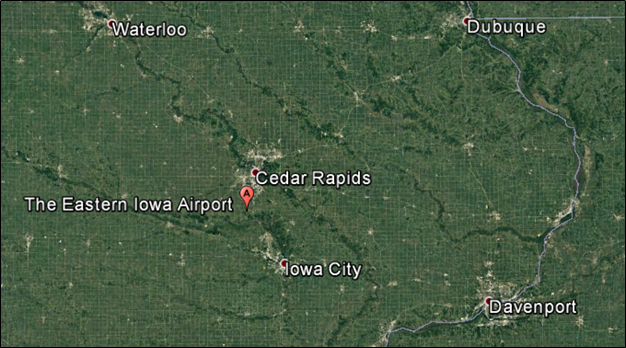Download PDF
Download page Introduction to the Extreme Value Theory Workshop.
Introduction to the Extreme Value Theory Workshop
Last Modified: 2025-04-21 12:31:22.763
Disclaimer: The United States Army Corps of Engineers has granted access to these data for instructional purposes only. Do not copy, forward, or release the information without United States Army Corps of Engineers approval.
Tools for the workshop:
- HEC-SSP version 2.3.1-beta.1 (portable version)
- HEC-SSP Distribution Fitting Analysis (DFA)
- HEC-SSP Mixed Population Analysis (MPA)
- Microsoft Excel
Download Initial Workshop Files
Introduction
In this workshop, you will explore extreme wind speed data from an automated weather station located at The Eastern Iowa Airport in Cedar Rapids, IA (formerly the Cedar Rapids Municipal Airport). The data come from the National Institute of Standards and Technology (NIST) extreme winds data set, which contains a long record of homogenized and meteorologically-typed wind observations across the United States. The observations are adjusted to account for changes in wind observation methods, including changes in the height and type of instrumentation, as well as variation in local site conditions affecting wind observations. The data are separated into distinct and independent storm events, so they do not need to be separated using an algorithm, or through manual means. The observations are also classified by the meteorological cause of the wind observation, generally broken into three categories: thunderstorm, non-thunderstorm (mid-latitude cyclone and frontal), and tropical. Iowa is generally not affected by tropical-type winds, so the analysis contained here will explore extreme winds caused by thunderstorms and mid-latitude cyclones/fronts.

Extreme winds play an important role in hazard analyses for dams and levees, which may fail due to wind-driven wave over-wash. During high water levels, high winds can cause enough water to splash over an earthen embankment to initiate erosion and then failure of that structure. This is especially problematic for earthen coastal defenses and earthen dams in regions prone to tropical storm-caused flooding. Analysis of wind-driven wave hazards typically requires a probabilistic analysis of extreme winds near the site of the structure being analyzed, and a response model (typically hydrodynamic) for estimating the impacts of extreme winds applied to the site. Frequency analysis of winds is also useful for building design codes, which contain guidance regarding structural design to withstand wind loadings.
The Hydrologic Engineering Center (HEC) Statistical Software Package (SSP) will be used to perform the frequency analyses in this workshop. The HEC-SSP project contains three data sets from the Cedar Rapids airport between about 1978 and 2010, which come from the NIST database:
- “All Independent”, which contains independent storm-maximum winds regardless of storm type
- “Independent Thunderstorms”, which contains independent storm-maximum winds caused only by individual thunderstorm events
- “Independent NT”, which contains independent storm-maximum winds caused only by individual non-thunderstorm (mid-latitude cyclone/frontal) events
General tasks in this workshop:
- Task 1 Heterogeneous Sample - Fit annual maximum series (AMS) and partial duration series (PDS) models to data which are a sample of all storm events regardless of type
- Task 2 Homogeneous Sample - Fit AMS and PDS models to data which are a sample of wind observations from only a single type of storm
- Task 3 Mixed Population Analysis - Compare the results of fitting an annual maximum model to all winds to an explicit treatment of the mixed population
Download Final Workshop Files
Next step: Task 1: Heterogeneous Sample
